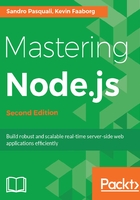
Optimizing your code
The simple optimizations of smart code design can really help you. Traditionally, JavaScript developers working in browsers did not need to concern themselves with memory usage optimizations, having quite a lot to use for what were typically uncomplicated programs. On a server, this is no longer the case. Programs are generally more complicated, and running out of memory takes down your server.
The convenience of a dynamic language is in avoiding the strictness that compiled languages impose. For example, you need not explicitly define object property types, and can actually change those property types at will. This dynamism makes traditional compilation impossible, but opens up some interesting new opportunities for exploratory languages such as JavaScript. Nevertheless, dynamism introduces a significant penalty in terms of execution speeds when compared to statically compiled languages. The limited speed of JavaScript has regularly been identified as one of its major weaknesses.
V8 attempts to achieve the sorts of speeds one observes for compiled languages for JavaScript. V8 compiles JavaScript into native machine code, rather than interpreting bytecode, or using other just-in-time techniques. Because the precise runtime topology of a JavaScript program cannot be known ahead of time (the language is dynamic), compilation consists of a two-stage, speculative approach:
- Initially, a first-pass compiler (the full compiler) converts your code into a runnable state as quickly as possible. During this step, type analysis and other detailed analysis of the code is deferred, prioritizing fast compilation – your JavaScript can begin executing as close to instantly as possible. Further optimizations are accomplished during the second step.
- Once the program is up and running, an optimizing compiler then begins its job of watching how your program runs, and attempting to determine its current and future runtime characteristics, optimizing and re-optimizing as necessary. For example, if a certain function is being called many thousands of times with similar arguments of a consistent type, V8 will re-compile that function with code optimized on the optimistic assumption that future types will be like the past types. While the first compile step was conservative with as-yet unknown and un-typed functional signature, this hot function's predictable texture impels V8 to assume a certain optimal profile and re-compile based on that assumption.
Assumptions help us make decisions more quickly, but can lead to mistakes. What if the hot function V8's compiler just optimized against a certain type signature is now called with arguments violating that optimized profile? V8 has no choice, in that case: it must de-optimize the function. V8 must admit its mistake and roll back the work it has done. It will re-optimize in the future if a new pattern is seen. However, if V8 must again de-optimize at a later time, and if this optimize/de-optimize binary switching continues, V8 will simply give up, and leave your code in a de-optimized state.
Let's look at some ways to approach the design and declaration of arrays, objects, and functions, so that you are helping, rather than hindering the compiler.